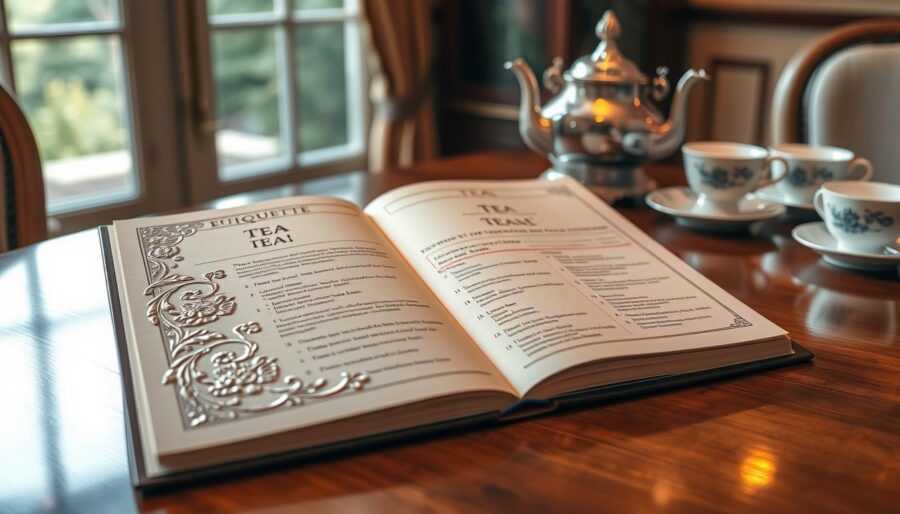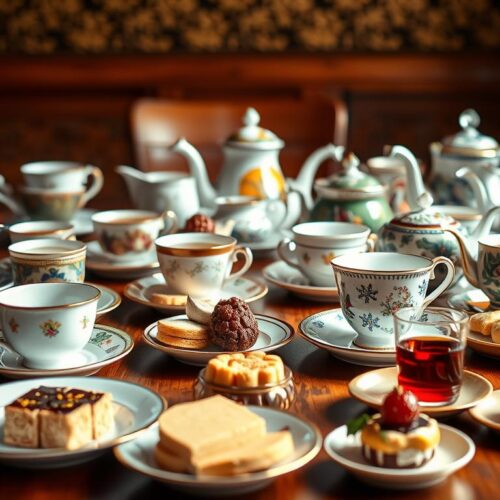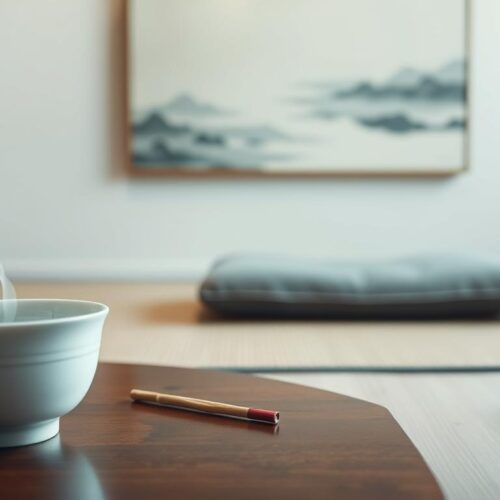Welcome to a journey through tea’s rich tradition. Each sip is filled with meaning. This guide will show you the social rules and ceremonies of tea culture globally. It’s key to know these customs, whether you’re hosting or attending a tea gathering.
You’ll learn why manners are important and get insights into tea’s history and importance. Let’s explore the refined world of tea and its honored traditions together.
Introduction to Tea Etiquette
In the world of tea, knowing how to act is very important. It shows respect to your host during tea events. It also helps you fit in better.
Different places have different tea customs. It’s key to learn these differences. Doing so improves your tea experience and shows you value the tradition. It makes everyone feel welcome and respected.
Learning about tea etiquette can make your gatherings better. Every cup of tea connects people and cultures. It brings peace and friendship. Knowing tea manners makes every moment more special and fun.
The Origins of Tea and Its Cultural Significance
Tea first grew in ancient China, starting a journey thousands of years ago. It became more than just a drink as it traveled the world. It turned into a way for people to express their culture. Tea has helped shape how we connect with others, showing us the depth of our social bonds.
In Britain, tea became especially meaningful during the Victorian era. Afternoon tea started then, showing off social status and offering a time to unwind and chat. This ritual made tea a key part of get-togethers, changing how people related to each other.
Tea is important in many cultures for reasons beyond just drinking it. Here is a look at what tea means in different places:
| Region | Customs | Cultural Significance |
|---|---|---|
| China | Tea ceremonies | Symbol of respect and harmony |
| Japan | Chanoyu (tea ceremony) | Philosophical practice and mindfulness |
| Britain | Afternoon tea | Social engagement and class distinction |
| India | Chai rituals | Everyday connection and hospitality |
Learing about tea’s origins and its role in different cultures shows us its value. It’s not just what people drink, but how they come together and share their lives. Tea reflects the unique traditions and shared values that have united communities through history.
Types of Tea and Their Etiquette
Knowing about different teas helps us enjoy their special traits and traditions. There are many teas like black, green, white, and herbal. Each has its own way of being served right.
When it comes to black tea, you can add milk or lemon to it. It’s best to pour the tea before the milk, a custom many follow, especially in the UK. Don’t stir too hard. This keeps your tea experience classy.
Green tea shines without extra flavors, letting its natural taste come through. To make green tea right, use cooler water and pour gently. This avoids making it bitter. In Asian traditions, it’s polite to sip it quietly, enjoying the peace it brings.
Herbal teas are great with a bit of honey or lemon. They’re usually served in clear cups, showing off their beautiful color. Pick cups that match the playful spirit of herbal tea.
| Type of Tea | Proper Serving Methods | Common Etiquette |
|---|---|---|
| Black Tea | Serve hot; add milk or lemon as desired | Pour tea first, respect silence when sipping |
| Green Tea | Brew at lower temperatures; serve without additives | Sip quietly, maintain calm atmosphere |
| Herbal Tea | Serve warm; honey or lemon may be added | Use transparent vessels; choose suitable cups |
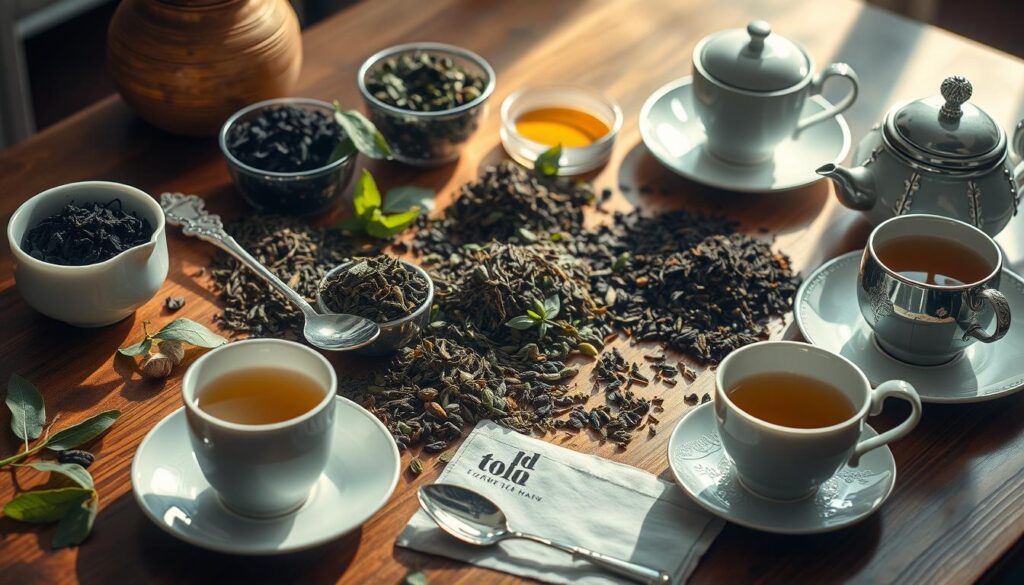
Setting the Perfect Tea Table
To set the perfect tea table, pay close attention to details and how you present everything. A well-set table makes the tea experience better and shows you know the rules of tea setting etiquette. Start with picking out china that fits your theme. Classic pieces like fine porcelain or vintage ones are great choices.
Setting up the table is all about where things go. Put the teapot in the middle, with cups, saucers, and plates filled with tasty treats around it. Make sure everything is easy to reach for your guests. Use linens like a clean tablecloth or fancy napkins to add style. Choose colors that go well with your room’s look.
Food should be the star, with small sandwiches, scones, and pastries beautifully displayed on tiered stands. This setup makes the table look better and taller. Don’t forget to offer sugar, milk, or lemon, based on what your guests like.
In essence, careful planning and focusing on tea setting etiquette will make your tea table not only useful but also visually delightful. Every single detail, from the china you use to how you arrange the food, creates a welcoming space for all to enjoy.
| Element | Purpose | Tip |
|---|---|---|
| Teapot | Central focus of the table | Choose a visually appealing design |
| Cups and Saucers | Serve the tea | Match with the teapot |
| Food Items | Provide refreshments | Use tiered stands for display |
| Table Linens | Enhance aesthetics | Select colors that complement your theme |
Tea Time: When Should You Serve?
Knowing when to serve tea is key to a great tea party. Different times, like afternoon tea and high tea, need different planning. Afternoon tea is best between 3 PM and 5 PM for a nice break. High tea, started by the working class, is around 6 PM or 7 PM.
The right timing is not just about when to pour tea but also about snack time. Aim for 2 to 3 hours for your tea event. This lets everyone enjoy their tea and snacks without rushing.
- Plan for a gradual serving of food and beverages to encourage social interaction.
- Schedule tea service at regular intervals rather than all at once.
- Be mindful of your guests’ preferences for tea type and snack pairings.
Knowing your guests makes your tea time special. Whether they’re new friends or old, think about what they like.
| Type of Tea Gathering | Typical Timing | Duration |
|---|---|---|
| Afternoon Tea | 3 PM – 5 PM | 2 – 3 hours |
| High Tea | 6 PM – 7 PM | 2 – 3 hours |
Good tea time planning and etiquette make your event smooth and fun. This keeps your guests happy and coming back.
How to Brew the Perfect Cup of Tea
Brewing tea is more than a process—it’s an art. It can totally change how you enjoy tea. Follow this guide to make your tea time special.
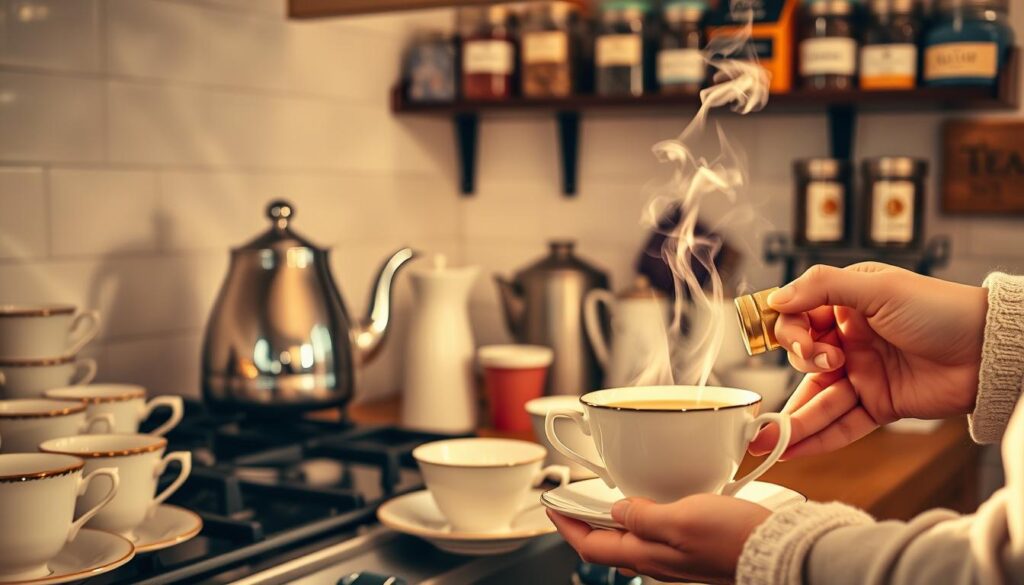
- Select Quality Tea Leaves: Pick fresh leaves. Choose from either loose-leaf tea or quality tea bags for the best taste.
- Measure Your Tea: Start with a teaspoon of loose-leaf per cup. You can add more if you like it strong.
- Use Filtered Water: Fresh, filtered water is best. The water’s minerals can alter tea’s taste.
- Heat Water to the Right Temperature: Tea types need different temperatures:
Type of Tea Water Temperature Steeping Time Green Tea 160-180°F 2-3 minutes Black Tea 200-212°F 3-5 minutes Herbal Tea 200-212°F 5-7 minutes - Steep with Care: Follow the recommended steeping time to avoid bitterness.
- Enjoy Your Tea: Finally, pour into your favorite cup and enjoy each sip.
Learning how to brew tea properly can really boost its flavor and smell. Making tea the right way doesn’t just give you a great drink. It also makes tea time a richer experience.
Social Codes and Politeness During Tea
Understanding social codes boosts enjoyment at tea gatherings. Such unwritten rules make everyone feel welcome. They guide everything from where to sit to what to talk about.
When you get to a tea event, wait for an invitation to sit. The host decides the seating, showing respect and social order. If unsure where to sit, it’s polite to ask the host.
Good conversations keep the tea time enjoyable. Ask about guests’ favorite teas or their tea culture experiences. But stay away from topics that might upset others.
If you don’t want tea, it’s okay to say no thanks. Saying, “Thank you, but I’ll pass for now,” is both polite and straightforward. This way, you respect your choices and the host’s effort.
In summary, knowing tea etiquette makes tea gatherings nicer for everyone. Following these social codes enhances the event’s feel.
Special Tea Traditions Worldwide
Tea is more than just a drink around the world; it’s part of many rich traditions. In Japan, the tea ceremony is a form of art. Matcha is made and served with great care and respect. This ceremony focuses on harmony, respect, purity, and peace.
In China, tea plays a vital role in society. The customs reflect family values, and ceremonies can last a long time. They show grace and hospitality. Tea is also part of big celebrations and important life moments, making a strong connection within families and communities.
The British afternoon tea adds a different touch to the world of tea. It’s a classy and formal event. People enjoy tea with light sandwiches and pastries, promoting conversation and togetherness.
Understanding these tea traditions from around the world helps us appreciate the drink more. Each unique tradition shows the values and history of its people. It shows how tea brings people together across the globe.
| Country | Tradition | Significance |
|---|---|---|
| Japan | Tea Ceremony | Emphasis on mindfulness and artistry |
| China | Family Tea Rituals | Cultural values and familial bonds |
| United Kingdom | Afternoon Tea | Social interaction and elegance |
Conclusion: Respecting Tea Etiquette
Tea etiquette is a way for different cultures and traditions to connect. This guide showed you the key points of tea manners, like the correct teas to serve and when to have tea parties. By following these practices, you make your tea times special and honor the history of each cup.
When you’re hosting or attending a tea event, remember these cultural norms. They help create a happy social setting and make every part of the tea experience better. It goes beyond just drinking tea. It’s about valuing the long-lasting traditions.
Respecting tea practices makes these moments more than simple rituals; they become deep social connections. As you continue your tea adventure, remember the principles of tea appreciation. Let them shape your actions. This way, your tea gatherings will show the grace and importance of this beloved drink.

